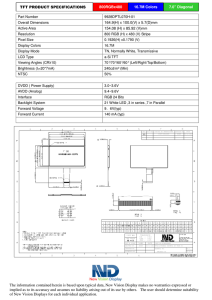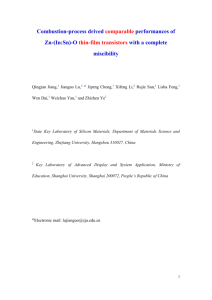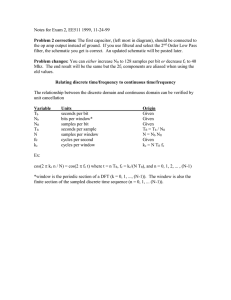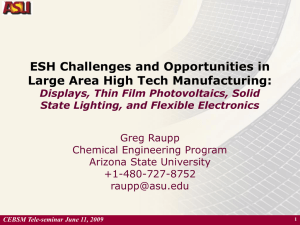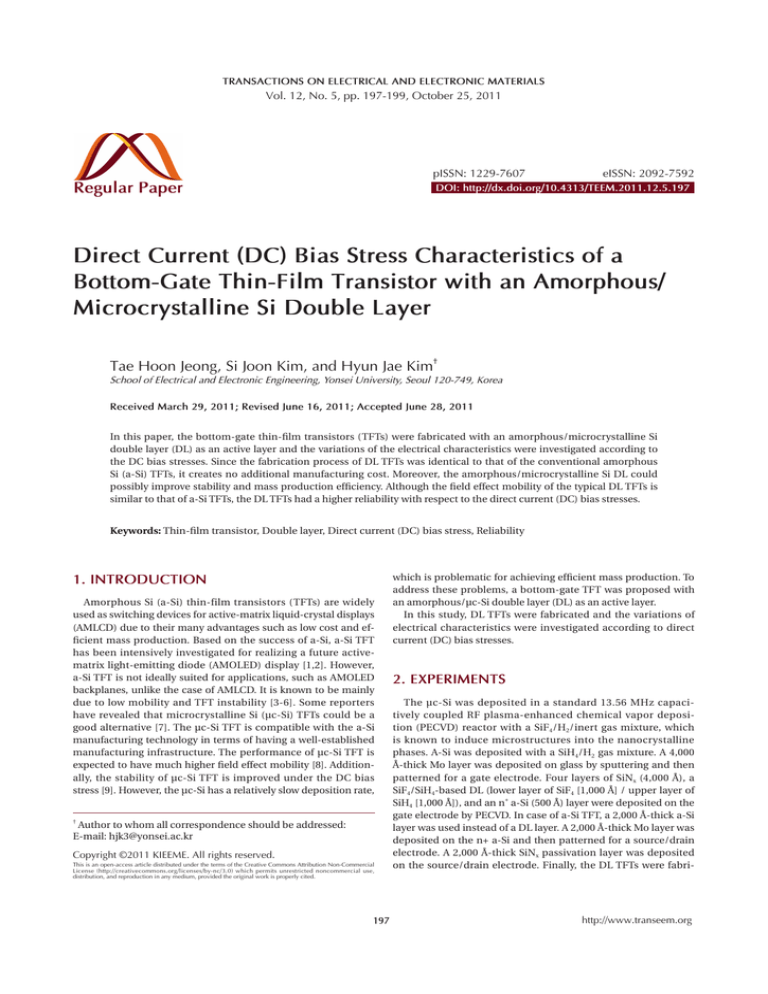
TRANSACTIONS ON ELECTRICAL AND ELECTRONIC MATERIALS
Vol. 12, No. 5, pp. 197-199, October 25, 2011
pISSN: 1229-7607
Regular Paper
eISSN: 2092-7592
DOI: http://dx.doi.org/10.4313/TEEM.2011.12.5.197
Direct Current (DC) Bias Stress Characteristics of a
Bottom-Gate Thin-Film Transistor with an Amorphous/
Microcrystalline Si Double Layer
Tae Hoon Jeong, Si Joon Kim, and Hyun Jae Kim
School of Electrical and Electronic Engineering, Yonsei University, Seoul 120-749, Korea
Received March 29, 2011; Revised June 16, 2011; Accepted June 28, 2011
In this paper, the bottom-gate thin-film transistors (TFTs) were fabricated with an amorphous/microcrystalline Si
double layer (DL) as an active layer and the variations of the electrical characteristics were investigated according to
the DC bias stresses. Since the fabrication process of DL TFTs was identical to that of the conventional amorphous
Si (a-Si) TFTs, it creates no additional manufacturing cost. Moreover, the amorphous/microcrystalline Si DL could
possibly improve stability and mass production efficiency. Although the field effect mobility of the typical DL TFTs is
similar to that of a-Si TFTs, the DL TFTs had a higher reliability with respect to the direct current (DC) bias stresses.
Keywords: Thin-film transistor, Double layer, Direct current (DC) bias stress, Reliability
1. INTRODUCTION
Amorphous Si (a-Si) thin-film transistors (TFTs) are widely
used as switching devices for active-matrix liquid-crystal displays
(AMLCD) due to their many advantages such as low cost and efficient mass production. Based on the success of a-Si, a-Si TFT
has been intensively investigated for realizing a future activematrix light-emitting diode (AMOLED) display [1,2]. However,
a-Si TFT is not ideally suited for applications, such as AMOLED
backplanes, unlike the case of AMLCD. It is known to be mainly
due to low mobility and TFT instability [3-6]. Some reporters
have revealed that microcrystalline Si (µc-Si) TFTs could be a
good alternative [7]. The µc-Si TFT is compatible with the a-Si
manufacturing technology in terms of having a well-established
manufacturing infrastructure. The performance of µc-Si TFT is
expected to have much higher field effect mobility [8]. Additionally, the stability of µc-Si TFT is improved under the DC bias
stress [9]. However, the µc-Si has a relatively slow deposition rate,
†
Author to whom all correspondence should be addressed:
E-mail: hjk3@yonsei.ac.kr
Copyright 2011 KIEEME. All rights reserved.
This is an open-access article distributed under the terms of the Creative Commons Attribution Non-Commercial
License (http://creativecommons.org/licenses/by-nc/3.0) which permits unrestricted noncommercial use,
distribution, and reproduction in any medium, provided the original work is properly cited.
Copyright 2011 KIEEME. All rights reserved.
197
which is problematic for achieving efficient mass production. To
address these problems, a bottom-gate TFT was proposed with
an amorphous/µc-Si double layer (DL) as an active layer.
In this study, DL TFTs were fabricated and the variations of
electrical characteristics were investigated according to direct
current (DC) bias stresses.
2. EXPERIMENTS
The µc-Si was deposited in a standard 13.56 MHz capacitively coupled RF plasma-enhanced chemical vapor deposition (PECVD) reactor with a SiF4/H2/inert gas mixture, which
is known to induce microstructures into the nanocrystalline
phases. A-Si was deposited with a SiH4/H2 gas mixture. A 4,000
Å-thick Mo layer was deposited on glass by sputtering and then
patterned for a gate electrode. Four layers of SiNx (4,000 Å), a
SiF4/SiH4-based DL (lower layer of SiF4 [1,000 Å] / upper layer of
SiH4 [1,000 Å]), and an n+ a-Si (500 Å) layer were deposited on the
gate electrode by PECVD. In case of a-Si TFT, a 2,000 Å-thick a-Si
layer was used instead of a DL layer. A 2,000 Å-thick Mo layer was
deposited on the n+ a-Si and then patterned for a source/drain
electrode. A 2,000 Å-thick SiNx passivation layer was deposited
on the source/drain electrode. Finally, the DL TFTs were fabri-
http://www.transeem.org
198
(a)
Trans. Electr. Electron. Mater. 12(5) 197 (2011): T. H. Jeong et al.
(a)
(b)
(b)
Fig. 1. (a) Schematic structure and (b) the typical transfer characteristics of a-Si thin-film transistor (TFT) and double layer (DL) TFT.
cated with W/L = 20/10 µm as shown in Fig. 1(a).
3. RESULTS AND DISCUSSION
Figure 1(b) shows the typical transfer characteristics of a-Si
TFT and DL TFT. The DL TFTs have field effect mobility within
0.5-0.7 cm2/Vs (measured at Vds of 5.1 V), threshold voltages (Vth)
within 4-6 V, and subthreshold swings (S.S) within 1.2-1.8 V/
decade. The electrical characteristics of the DL TFTs are comparable to those of the conventional a-Si TFTs, except for the offcurrent levels. The abnormality of the off-current level may be
caused by several causes, for example, source and drain region
conductivity and active layer’s thickness.
To study the DL TFT degradation, various DC bias stresses
were applied to the substrates. Specifically, a-Si TFTs were fabricated to compare the degradation differences to DL TFT. The
fabrication process of a-Si TFT was identical to that of DL TFT,
except that the active layer was replaced with a 2,000 Å-thick
SiH 4-based a-Si layer deposited by PECVD. The degradation
mechanisms of a-Si TFTs have already been reported [10-12].
Degradation occurs by charge trapping in the gate insulator and
by the creation of dangling bond defects in the channel near the
Si-insulator interfaces [10]. Due to these degradation mechanisms, the Vth shift was observed in a-Si TFTs with almost all
stress conditions, and the shifts were significantly dominant in
the positive gate bias stress.
Figure 2 shows the Vth shift and mobility variations of the DL
TFT and a-Si TFT after positive gate bias stress (Vgs = 30 V, Vds = 0 V)
for 10, 100, 1,000, 3,000, 6,000, and 10,000 seconds.
The DL TFTs do not show the Vth shift degradation phenomenon, while the a-Si TFT suffers a significant Vth shift of approximately 2.4 V. The results of the positive gate bias stress indicate
that the degradation mechanism of the DL TFT was not similar
to that of a-Si TFT. Although the charge trapping in the SiNx layer
and the creation of dangling bond defects in the Si-insulator
interfaces are primary factors in the a-Si TFT degradation, in our
results, charge trapping in the insulator layer could not be considered dominant because the SiNx deposition conditions were
not changed between DL TFT and a-Si TFT. After 10,000 seconds,
Fig. 2. (a) The Vth shift and (b) the mobility variations of the double
layer (DL) thin-film transistor (TFT) and a-Si TFT after positive gate
bias stress (Vgs = 30 V, Vds = 0 V) for 10, 100, 1,000, 3,000, 6,000, and
10,000 seconds.
the a-Si TFT mobility decrease was measured as 0.13 cm2/Vs,
which was approximately two to three times larger than that
of DL TFT. The mobility decrease could be attributed to defect
generation, such as the breaking of Si-H bonds in the Si channel
bulk rather than at the Si-insulator interface.
To study the defect generation in the Si channel in more detail,
self-heating stress tests were conducted with the DL TFT and a-Si
TFT within the linear region (Vgs = 20 V, Vds = 10 V) and saturation
region (Vgs = 20 V, Vds = 20 V), respectively. It has been reported
that the Vth shift of a-Si TFT in the saturation region could be reduced with respect to the linear region [1]. As Vds increased, the
charge injection amount at the Si-insulator interface was lowered, thus reducing the Vth shift degradation in the a-Si TFT. Table
1 shows that the variations in transfer characteristics of the DL
TFT and a-Si TFT were measured at Vds = 5.1 V after self-heating
stress with (a) Vgs = 20 V, Vds = 10 V, linear region stress and (b) Vgs
= 20 V, Vds = 20 V, saturation region stress for 10,000 seconds.
Under the same stress conditions, a-Si TFT had a large Vth shift
and polycrystalline Si (poly-Si) TFT had joule heating mobility
degradation [13]. In both bias stress conditions of DL TFT, a significant Vth shift was not observed. Additionally, the self-heating
degraded DL TFT more in the linear region than in the saturation
region, illustrating that the DL TFT has a degradation mechanism similar to a-Si TFT. However, the degradation of DL TFT is
much less than that of a-Si TFT under these stresses conditions.
On the other hand, in the self-heating operation of poly-Si TFT,
degradation was characterized by i) a significant decrease in the
on-current value and ii) a significant increase in the off-current
value [13]. The research herein revealed that the DL TFT had
not suffered the same degradation mechanisms encountered in
previous research, suggesting the degradation mechanism was
different than that of poly-Si TFT. To this end, the DL TFT was
degraded with mechanisms similar to those of a-Si TFT under
Trans. Electr. Electron. Mater. 12(5) 197 (2011): T. H. Jeong et al.
199
Table 1. Variations in transfer characteristics of the DL TFT and a-Si
TFT measured at Vds = 5.1 V after self-heating stress with (a) Vgs = 20 V,
Vds = 10 V, linear region stress and (b) Vgs = 20 V, Vds = 20 V, saturation
region stress for 10,000 seconds.
Self Heating
(Linear)
Self Heating
(Saturation)
DL TFT
Δ Mobility = -0.076
a-Si TFT
Δ Mobility = -0.32
Δ Vth = 0.32
Δ S.S = 0.24
Δ Mobility = -0.030
Δ Vth = 0.06
Δ Vth = 1.45
Δ S.S = 0.56
Δ Mobility = -0.14
Δ Vth = 0.7
Δ S.S = 0.22
Δ S.S = 0.43
DL: double layer, TFT: thin-film transistor.
Fig. 3. The transfer characteristics of the double layer thin-film transistor measured at Vds = 0.1 V and Vds = 5.1 V before and after hot carrier stress (Vgs = 5 V, Vds = 20 V, during 10,000 seconds).
the self-heating stress condition. The self-heating degradation
was known to be due to the breaking of Si-H bonding in the bulk
Si channel rather than at the Si-insulator interface.
Figure 3 represents the transfer characteristics of the DL TFT
measured at Vds = 0.1 V and Vds = 5.1 V before and after the hot
carrier stress (Vgs = 5 V, Vds = 20 V, during 10,000 seoncds). After
the hot carrier stress, the off- and on-current indicated almost no
degradation. The on-current characteristics of the DL TFT were
nearly unchanged when measured at low drain voltage (Vds = 0.1
V), indicating the interface states were barely created during hot
carrier stress condition.
When the source and drain contacts were reversed after the
hot carrier stress, the off-current was slightly lower than the forward measurement. The reduction in current illustrates that the
trap states near the drain region of DL TFT are locally created by
impact ionization during the bias stress. Similar to DL TFT, the
off- and on-current of a-Si TFT had almost no degradation at Vds
= 0.1 V and Vds = 5.1 V under hot carrier stress. The similarity under the hot carrier stress may be caused by the similar on-current
levels of DL TFT and a-Si TFT, as degradation mainly depends
on the applied source-drain voltages, hot carrier concentrations,
and material characteristics. The degradation mechanism of
poly-Si TFT was caused by the hot carrier stress, with a significant increase of off-current and decrease of on-current [14].
Therefore, in terms of degradation mechanisms, DL TFT was unlike the poly-Si TFT.
4. SUMMARY
In summary, the DL TFTs, which were the same as the conventional a-Si TFTs process except that the active layer was replaced
by amorphous/microcrystalline Si DL, were fabricated and the
electrical characteristics under DC bias stresses were investigated. The DL TFT is directly applicable to the TFT fabrication
process for commercial devices, ensuring efficient fabrication for
mass production and is expected to improve the slow deposition
rate of the active layer in µc-Si TFT fabrication process, as the deposition rate of a-Si layer is much faster than µc-Si. Because the
degradation characteristics of DL TFT were unique, the degradation mechanism of DL TFT is explained unlike that of a-Si TFT
or of poly-Si TFT. It is believed that the DL TFT degradation was
mainly caused by the defect generation in the Si channel rather
than charge trapping in the gate insulator or trap state creation
in the region near the drain. It means that the DL TFT could
achieve higher reliability than a-Si TFT or poly-Si TFT. Therefore,
these desirable characteristics of DL TFTs might overcome the
limitations of a-Si TFTs and µc-Si TFTs.
ACKNOWLEDGMENTS
This work was supported by the National Research Foundation
of Korea (NRF) through the National Research Laboratory Program grant funded by the Korean Ministry of Education, Science
and Technology (MEST) [no. R0A-2007-000-10044-0(2007)].
REFERENCES
[1] T. Tsujimura, Jpn. J. Appl. Phys. 43, 5122 (2004) [DOI: 10.1143/
JJAP.43.5122].
[2] G. R. Chaji, S. J. Ashtiani, N. Safavian, and A. Nathan, Society
for Information Display International Symposium, Digest of
Technical Papers, p. 216 (2006).
[3] K. S. Girotra, Y. M. Choi, B. J. Kim, Y. R. Song, B. Choi, S. H.
Yang, S. Kim, and S. Lim, J. Soc. Inf. Disp. 15, 113 (2007) [DOI:
10.1889/1.2709730].
[4] K. S. Girotra, J. H. Souk, K. Chung, S. K. Lim, S. Y. Kim, B. J. Kim, S.
H. Yang, B. R. Choi, J. C. Goh, Y. R. Song, and Y. M. Choi, Society
for Information Display International Symposium, Digest of
Technical Papers, p. 1972 (2006).
[5] K. S. Jeong, S. J. Kwon, and E. S. Cho, J. of KIEEME 22, 1058
(2009).
[6] S. H. Kim, J. H. Hur, K. M. Kim, J. H. Koo, and J. Jang, J. Korean
Phys. Soc. 48, S80 (2006).
[7] K. Y. Chan, J. Kirchhoff, A. Gordijn, D. Knipp, and H.
Stiebig, Thin Solid Films 517, 6383 (2009) [DOI: 10.1016/
j.tsf.2009.02.101].
[8] C. H. Lee, A. Sazonov, and A. Nathan, Appl. Phys. Lett. 86,
222106 (2005) [DOI: 10.1063/1.1942641].
[9] P. Roca i Cabarrocas, R. Brenot, P. Bulkin, R. Vanderhaghen, B.
Drevillon, and I. French, J. Appl. Phys. 86, 7079 (1999) [DOI:
10.1063/1.371795].
[10] H. Meiling and R. E. I. Schropp, Appl. Phys. Lett. 70, 2681 (1997)
[DOI: 10.1063/1.118992].
[11] F. R. Libsch and J. Kanicki, Appl. Phys. Lett. 62, 1286 (1993) [DOI:
10.1063/1.108709].
[12] A. V. Gelatos and J. Kanicki, Appl. Phys. Lett. 57, 1197 (1990)
[DOI: 10.1063/1.103484].
[13] S. Inoue, M. Kimura, and T. Shimoda, Jpn. J. Appl. Phys. 42,
1168 (2003) [DOI: 10.1143/JJAP.42.1168].
[14] N. D. Young, A. Gill, and M. J. Edwards, Semicond. Sci. Technol.
7, 1183 (1992) [DOI: 10.1088/0268-1242/7/9/007].

